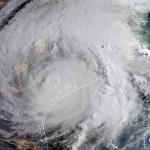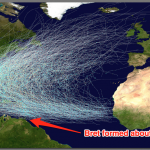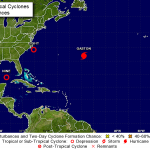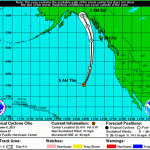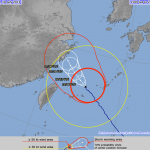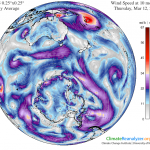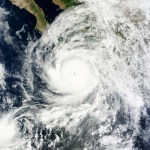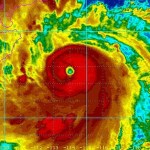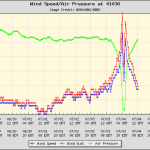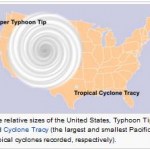hurricanes
Hurricane Harvey visited a near-biblical deluge upon Houston, dropping over 40 inches of rain on parts of the city. The situation resulted from warmer ocean waters, more moisture in the atmosphere, and Houston's geography along with its preparedness for the disaster. Greg Laden shows hotter sea surface temperatures in the Tropics and the Gulf of Mexico allowed Harvey to gain extra strength as it formed and re-formed on its way to the United States. In another post, Greg asks if Houston's infrastructure could have been better-prepared for this type of rainfall, suggesting that "Houston is…
First, some important pieces related to hurricanes:
Cindy George in the Houston Chronicle: City's underserved population foresees uneven recovery
Aaron Caroll & Austin Frakt at the New York Times' Upshot: The Long-Term Health Consequences of Hurricane Harvey
Lisa Rein in the Washington Post: Trump would slash disaster funding to the very agencies he’s praising for Harvey response
Adrian Florido at NPR: Houston's Undocumented Residents Left Destitute And Fearful In Harvey's Wake
Vann R. Newkirk II in The Atlantic: The Legal Crises to Follow in Hurricane Harvey's Wake
Sheri Fink &…
UPDATE (Aug 30th)
Irma is a new named storm in the Eastern Atlantic. See this post for details, eventually.
UPDATE (Aug 29th)
There is a system currently raining on Cabo Verde, off the West Coast of Africa (nee Cape Verde) that is expected to develop. It is on the verge of becoming a tropical depression. The National Hurricane Center has estimated that there is a high probability of this stormy feature becoming a tropical storm in a couple of days or so. If it gets a name, it will be Irma, unless some other large rotating wet object takes that name first.
UPDATE (Aug 29th)
How is the…
Original Post:
The Atlantic storms are getting interesting.
Two different systems are poised to become named storms, but it is not clear which one will be awarded the name Hermine, and which one Ian. If the storm recently near Cuba develops as expected, it could become a weak hurricane before making landfall along Florida's Gulf coast. This will not likely be a very impressive hurricane, but it will be big and wet, and the area is already experiencing too much water. Flooding will ensue.
A third system is moving off of Africa, with 40% chance of forming into a storm over the next several…
A quick note about the current Atlantic hurricane season. With resect to just the US, we've had a fairly low level season, and it is easy to become complacent about this time, but in fact, the risks from Atlantic hurricanes rise about this time of year, so pay attention. Watch for Hermine. More on that below.
We are approximately in the middle of the 2016 Atlantic Hurricane Season, by calendar time. The number of named storms (tropical storms plus hurricanes) predicted for this year is about 14, taking the average of all the predictions made so far, and there have been 7 storms including…
"And yet many people today believe that weather modification is a hoax: the early overselling of rainmaking somehow caused it, down the line, to be grouped in the public mind with conspiracy theories about mind-altering 'chemtrails,' shock-jock speculation that the government manufactures tornadoes, and paranoid fantasies about the 'weather wars' involving earthquakes broadcast via the stratosphere. The reality is far less dramatic." -Ginger Strand, The Brothers Vonnegut
In 1945, after the United States dropped atomic bombs on Hiroshima and Nagasaki, there was much hand-wringing in the…
South Carolina Floods
I haven't said much about this partly because there is so much good coverage, but South Carolina's floods, still ongoing, are going to get on the list of worst weather events of 2015. Since these floods are amounting to a one in 1,000 year event, they are actually on the list of worst weather events since Vladimir the Great died, Cnut the Great invaded Enlgand (unrelated event), Eric Haakonsson outlaws berzerkers in Norway, and Olaf Haraldson declared himself King of Norway.
And yes, that event was climate change enhanced in at least two ways, maybe three. With global…
UPDATE: There are significant changes (as of Friday mid day Middle America Time) in the track and strength of the storm, mostly good news for china. See here for updates.
A large typhoon (hurricane) is heading for China and is expected to make landfall in the vicinity of Shanghai. The image above is from the Japan Meteorological agency, and the image below is from JAM via Jeff Masters Blog.
"Typhoon Chan-hom as seen by radar on Okinawa at 7:45 pm EDT Thursday (08:45 JST Friday, July 10), 2015. At the time, Chan-hom was a Category 4 storm with 130 mph winds."
Apparently Chan-hom will…
Pam is a tropical cyclone of category 5 strength, but is churning over waters that have high temperatures at depth, a phenomenon we seem to be seeing more often lately, as a result of anthropogenic global warming. That is why I call it "AGW Class." Strong Category 5, deep heat enhanced. It is said that this is one of only 10 Category 5 storms recorded in the basin since good data are available. The Weather Underground has the story.
In addition, there are three other tropical cyclones extant in the Pacific.
Nathan is just on the Tropical Storm-Hurricane boundary and is heading for Cape…
Odile was the strongest hurricane to strike the Baja Peninsula during the period of available data, roughly similar to Hurrican Olivia (1967). The storm reached Category 4 strength but was then weakened because of interaction with the effects of a prior hurricane in the area (Norbert). At the moment, Odile is a tropical storm and still in the Baja. There was flooding, and two fatalities, including a lightning strike and a nine year old boy taken by floodwaters. Several building in Acapulco were damaged. There has been a lot of damage and disruption in the Baja region.
Tropical Storm Polo…
There is a major typhoon (hurricane) in the Western Pacific, Rammusan, which has already caused flooding and damage in the Phillipenes, where it killed 12 people, heading for southern China, and expected to affect northern Vietnam later on. From Accuweather:
Warm ocean waters combined with light wind shear will allow the storm to remain well organized through Friday as it approaches Hainan Island. Rammasun will likely bring widespread winds of 100 mph to northern Hainan Island on Friday afternoon and Friday night with higher gusts. Widespread wind damage is expected across northern Hainan,…
Filed under "data can be cool"
This is a graph of wind and air pressure at a weather station as a hurricane passes directly over. Notice the double spikes as each eye wall passes overhead.
Solar cells made with bismuth vanadate achieve a surface area of 32 square meters per gram. This compound can be paired with cheap oxides to split water molecules (and make hydrogen) with record efficiency.
Short-term geoengineering could postpone global warming, only to have it happen more quickly in the future.
Carotenoids tinge blackbird bills a deep orange, signalling fitness; birds with oranger bills are "are heavier and larger, have less blood parasites and pair with females in better condition than males with yellow bills."
Fibroblasts can extrude a tidy biological…
Typhoon Haiyan, which made landfall in the Philippines on Nov. 7, is another sobering reminder of the severe weather we are provoking through climate change. It is unofficially the strongest recorded cyclone to ever make landfall, with wind speeds up to 195 mph, 70% stronger than Hurricane Sandy. Villages are flattened, and more than 5,000 people are confirmed dead (as of 11/22). Greg Laden says that tropical cyclones feed on heat energy from the sea’s surface, from seas we know are getting warmer. Haiyan was a storm that blew past the most dire classification, Category 5, which tops out at a…
This is just a quick post to suggest an answer to the question posed by Greg Laden here: should we have a category 6 and above for hurricanes. My answer is no.
I say this in agreement with many of the points expressed in Greg's post, mainly that category 5 basically means total destruction and for all practical purposes what is the difference between flattened like a dirt road or flattened like a paved one? But in acknowledgment of the other arguments and points of view, I would suggest further categories into the higher wind speeds in the form of Category 5A, 5B, 5C etc. It…
I’m sure the measurements are still being checked and adjusted but it is clear that Typhoon Haiyan/Yolanda was one of the most powerful tropical cyclones (termed “Typhoon” in the western Pacific) ever recorded. There are several ways to measure how big and bad a tropical cyclone is including it’s overall size from end to end, how low the barometric pressure gets, how high the sustained wind speed is, and how wide that wind field is. In addition, when a typhoon hits land details matter. The front right quadrant of a counter-clockwise spinning typhoon packs the maximum punch and if that part of…
Paul Douglas has also been following the Al Gore OMG Category Six!!1!!! discussion. Here's what he has to say about the thing I just wrote about:
I'm thinking we might need to add some degrees onto the thermometer next week!
These things are all connected.
A couple of days ago a good ally in the climate change fight ... the fight to make people realize that climate change is not some librul conspiracy to raise taxes on the rich ... goofed. It was a minor goof, barely a goof at all. We do not yet know the nature of the goof but it was somewhere between saying something in a slightly clumsy manner and a bit of misremembering something that happened in 2005 during an interview. That's it. Nothing else to see here.
But that goof has been wrenched form its context and turned into a senseless and embarrassingly…
The National Academies Press of the United States has recently released a report that will be of interest to those of you concerned with climate change (which better be every one of you dammit!). The report talks about increasing floods due to weather whiplash and sea level rise due to glacial melting (and subsidence), mainly in relation to the levees program and insurance, but also more generally. Here's a small excerpt to give you a flavor:
Community flood risk scenarios will continue to evolve as change occurs. Climate change will have a variety of regional impacts, and the geographic…
Probably.
The Tropical Meteorology Project at Colorado State University makes annual predictions of hurricane season activity, and they released one of these predictions today. This particular group has a good track record, although I would worry that they tenaciously hold to the idea that global warming is not a factor in hurricane development despite the fact that some of the factors (a disrupted ENSO and high SST) that are most affected in the Atlantic by global warming actually drive their predictions. Still, their predictions seem to be based on good empirical data and are probably…
